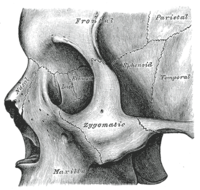
Photo from wikipedia
Background: Dural arteriovenous fistulas (dAVFs) are extremely rare in the superior orbital fissure, and they exhibit ocular symptoms similar to the dAVF in the cavernous sinus because of the intraorbital… Click to show full abstract
Background: Dural arteriovenous fistulas (dAVFs) are extremely rare in the superior orbital fissure, and they exhibit ocular symptoms similar to the dAVF in the cavernous sinus because of the intraorbital venous congestion. Hence, the distinction of these conditions is imperative because of some inherent differences in endovascular treatment techniques. Case Description: A 58-year-old woman presented with a gradually worsening left eyeball protrusion and conjunctival congestion. The digital subtraction angiography revealed a dAVF with a shunting point in the left superior orbital fissure. Moreover, the inferolateral trunk of the left internal carotid artery and the left middle meningeal artery were involved as feeding arteries. Shunting blood flow drained into the facial vein through the superior ophthalmic vein (SOV) but not into the cavernous sinus, which was located just posterior to the superior orbital fissure. We performed transvenous coil embolization in the SOV through the facial vein, and the symptoms disappeared completely. Conclusion: We experienced a case of a dAVF in the superior orbital fissure. This case presented a possibility of the presence of one subtype of the dAVF in the part of the cavernous sinus separated at the superior orbital fissure in front. Transvenous coil embolization in the SOV through the facial vein efficiently occluded the fistula.
Journal Title: Surgical Neurology International
Year Published: 2018
Link to full text (if available)
Share on Social Media: Sign Up to like & get
recommendations!